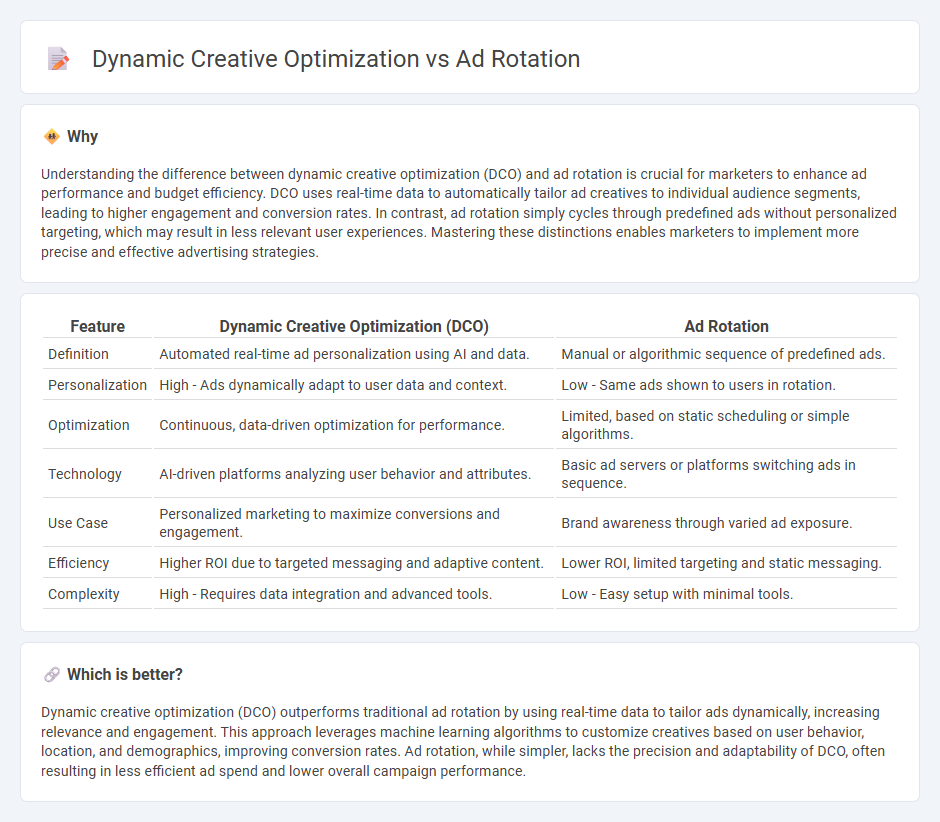
Dynamic creative optimization leverages real-time data and machine learning algorithms to tailor ad content for individual users, boosting engagement rates and conversion performance. In contrast, traditional ad rotation cycles through predefined creatives at set intervals without personalization, often resulting in less effective audience targeting. Discover how dynamic creative optimization can transform your marketing strategy and maximize ROI.
Why it is important
Understanding the difference between dynamic creative optimization (DCO) and ad rotation is crucial for marketers to enhance ad performance and budget efficiency. DCO uses real-time data to automatically tailor ad creatives to individual audience segments, leading to higher engagement and conversion rates. In contrast, ad rotation simply cycles through predefined ads without personalized targeting, which may result in less relevant user experiences. Mastering these distinctions enables marketers to implement more precise and effective advertising strategies.
Comparison Table
| Feature | Dynamic Creative Optimization (DCO) | Ad Rotation |
|---|---|---|
| Definition | Automated real-time ad personalization using AI and data. | Manual or algorithmic sequence of predefined ads. |
| Personalization | High - Ads dynamically adapt to user data and context. | Low - Same ads shown to users in rotation. |
| Optimization | Continuous, data-driven optimization for performance. | Limited, based on static scheduling or simple algorithms. |
| Technology | AI-driven platforms analyzing user behavior and attributes. | Basic ad servers or platforms switching ads in sequence. |
| Use Case | Personalized marketing to maximize conversions and engagement. | Brand awareness through varied ad exposure. |
| Efficiency | Higher ROI due to targeted messaging and adaptive content. | Lower ROI, limited targeting and static messaging. |
| Complexity | High - Requires data integration and advanced tools. | Low - Easy setup with minimal tools. |
Which is better?
Dynamic creative optimization (DCO) outperforms traditional ad rotation by using real-time data to tailor ads dynamically, increasing relevance and engagement. This approach leverages machine learning algorithms to customize creatives based on user behavior, location, and demographics, improving conversion rates. Ad rotation, while simpler, lacks the precision and adaptability of DCO, often resulting in less efficient ad spend and lower overall campaign performance.
Connection
Dynamic creative optimization (DCO) enhances ad rotation by automatically tailoring ad creatives in real-time based on user data and behavior, ensuring each viewer sees the most relevant content. This technology uses machine learning algorithms to test multiple ad variants simultaneously during rotation, optimizing performance by prioritizing higher-engagement creatives. Integrating DCO with ad rotation maximizes campaign effectiveness through increased personalization, improved click-through rates, and more efficient budget allocation.
Key Terms
Ad Rotation
Ad rotation systematically alternates multiple ads within the same placement to evenly distribute impressions and gather performance data, optimizing campaign insights and engagement rates. This method ensures balanced exposure, allowing advertisers to identify the most effective creatives through real-time testing and analysis. Explore more to discover how ad rotation can enhance your advertising strategy and boost ROI.
Dynamic Creative Optimization (DCO)
Dynamic Creative Optimization (DCO) leverages real-time data to automatically tailor ad creatives based on audience behavior and preferences, enhancing personalization and campaign performance. Unlike ad rotation, which cycles through a fixed set of ads, DCO optimizes each impression by selecting the best combination of images, text, and calls-to-action to maximize engagement and conversions. Explore how DCO can revolutionize your advertising strategy with advanced targeting and automation techniques.
Personalization
Ad rotation alternates multiple static ads within a campaign, limiting personalization by showing predefined creatives without real-time adjustments. Dynamic creative optimization (DCO) enhances personalization by automatically tailoring ad components--such as images, headlines, and calls-to-action--to individual user data and behaviors for increased engagement. Explore how DCO can maximize campaign effectiveness through advanced personalization strategies.
Source and External Links
Ad Rotation | How it Works | Best Practices - Ad rotation is the process of displaying different ads to a specific audience within a defined timeframe, allowing advertisers to test and optimize ads either by showing them equally (standard rotation) or by favoring better-performing ads (optimized rotation).
Ad rotation - Wikipedia - Ad rotation involves showing multiple ads in a single web page location, with the goals of serving multiple advertisers, keeping ads fresh, and increasing exposure, implemented via server-side, client-side, or service-based technologies.
What is Ad Rotation? - SimpleTiger - Ad rotation is the strategy of displaying multiple ad versions in the same space over time to test performance metrics like click-through and conversions, helping businesses optimize digital ads continuously.
 dowidth.com
dowidth.com